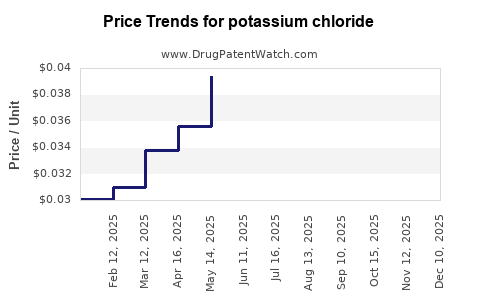Potassium chloride - Generic Drug Details
✉ Email this page to a colleague
What are the generic drug sources for potassium chloride and what is the scope of freedom to operate?
Potassium chloride
is the generic ingredient in forty-five branded drugs marketed by Savage Labs, Upsher Smith Labs, Nesher Pharms, Actavis Labs Fl Inc, Adare Pharms Inc, Amneal Pharms, Chartwell Molecular, Endo Operations, Glenmark Pharms Ltd, Granules, Lupin Ltd, Novel Labs Inc, Padagis Us, Prinston Inc, Strides Pharma, Teva, Tris Pharma Inc, Zydus Pharms, Genus, Amneal, Belcher, Epic Pharma Llc, Novitium Pharma, Rubicon, Kv Pharm, Abraxis Pharm, B Braun, Baxter Hlthcare, Fresenius Kabi Usa, Gd Searle Llc, Hospira, Intl Medication, Lilly, Luitpold, Miles, Nexus Pharms, Pharma Serve Ny, Watson Labs, Nexus, Icu Medical Inc, Anda Repository, Apotex, Genus Lifesciences, Pharm Assoc, Sciegen Pharms Inc, Wes Pharma Inc, Future Pak, Abbvie, Apothecon, Ascent Pharms Inc, Aurobindo Pharma, Aurobindo Pharma Ltd, Breckenridge, Chartwell Rx, Copley Pharm, Guangzhou Novaken, Macleods Pharms Ltd, Mylan, Rising, Schering, Sigmapharm Labs Llc, Twi Pharms, Yichang Humanwell, and Novartis, and is included in one hundred and thirty-two NDAs. Additional information is available in the individual branded drug profile pages.There are twenty-four drug master file entries for potassium chloride. Eighty-eight suppliers are listed for this compound. There are two tentative approvals for this compound.
Summary for potassium chloride
| US Patents: | 0 |
| Tradenames: | 45 |
| Applicants: | 64 |
| NDAs: | 132 |
| Drug Master File Entries: | 24 |
| Finished Product Suppliers / Packagers: | 88 |
| Raw Ingredient (Bulk) Api Vendors: | 314 |
| Patent Applications: | 5,871 |
| Drug Prices: | Drug price trends for potassium chloride |
| Drug Sales Revenues: | Drug sales revenues for potassium chloride |
| What excipients (inactive ingredients) are in potassium chloride? | potassium chloride excipients list |
| DailyMed Link: | potassium chloride at DailyMed |
Generic filers with tentative approvals for POTASSIUM CHLORIDE
The 'tentative' approval signifies that the product meets all FDA standards for marketing, and, but for the patents / regulatory protections, it would approved.
Pharmacology for potassium chloride
| Drug Class | Osmotic Laxative Potassium Salt |
| Mechanism of Action | Osmotic Activity |
| Physiological Effect | Increased Large Intestinal Motility Inhibition Large Intestine Fluid/Electrolyte Absorption |
Anatomical Therapeutic Chemical (ATC) Classes for potassium chloride
US Patents and Regulatory Information for potassium chloride
| Applicant | Tradename | Generic Name | Dosage | NDA | Approval Date | TE | Type | RLD | RS | Patent No. | Patent Expiration | Product | Substance | Delist Req. | Exclusivity Expiration |
|---|---|---|---|---|---|---|---|---|---|---|---|---|---|---|---|
| Tris Pharma Inc | POTASSIUM CHLORIDE | potassium chloride | SOLUTION;ORAL | 214076-001 | Jan 26, 2022 | DISCN | No | No | ⤷ Sign Up | ⤷ Sign Up | ⤷ Sign Up | ||||
| Abraxis Pharm | POTASSIUM CHLORIDE | potassium chloride | INJECTABLE;INJECTION | 086713-001 | Approved Prior to Jan 1, 1982 | DISCN | No | No | ⤷ Sign Up | ⤷ Sign Up | ⤷ Sign Up | ||||
| Baxter Hlthcare | POTASSIUM CHLORIDE 10MEQ IN PLASTIC CONTAINER | potassium chloride | INJECTABLE;INJECTION | 019904-001 | Dec 26, 1989 | AP | RX | Yes | Yes | ⤷ Sign Up | ⤷ Sign Up | ⤷ Sign Up | |||
| >Applicant | >Tradename | >Generic Name | >Dosage | >NDA | >Approval Date | >TE | >Type | >RLD | >RS | >Patent No. | >Patent Expiration | >Product | >Substance | >Delist Req. | >Exclusivity Expiration |
Expired US Patents for potassium chloride
| Applicant | Tradename | Generic Name | Dosage | NDA | Approval Date | Patent No. | Patent Expiration |
|---|---|---|---|---|---|---|---|
| Nesher Pharms | MICRO-K | potassium chloride | CAPSULE, EXTENDED RELEASE;ORAL | 018238-001 | Approved Prior to Jan 1, 1982 | ⤷ Sign Up | ⤷ Sign Up |
| Schering | POTASSIUM CHLORIDE | potassium chloride | TABLET, EXTENDED RELEASE;ORAL | 019439-001 | Jun 13, 1986 | ⤷ Sign Up | ⤷ Sign Up |
| Apothecon | KLOTRIX | potassium chloride | TABLET, EXTENDED RELEASE;ORAL | 017850-001 | Approved Prior to Jan 1, 1982 | ⤷ Sign Up | ⤷ Sign Up |
| >Applicant | >Tradename | >Generic Name | >Dosage | >NDA | >Approval Date | >Patent No. | >Patent Expiration |
Make Better Decisions: Try a trial or see plans & pricing
Drugs may be covered by multiple patents or regulatory protections. All trademarks and applicant names are the property of their respective owners or licensors. Although great care is taken in the proper and correct provision of this service, thinkBiotech LLC does not accept any responsibility for possible consequences of errors or omissions in the provided data. The data presented herein is for information purposes only. There is no warranty that the data contained herein is error free. thinkBiotech performs no independent verification of facts as provided by public sources nor are attempts made to provide legal or investing advice. Any reliance on data provided herein is done solely at the discretion of the user. Users of this service are advised to seek professional advice and independent confirmation before considering acting on any of the provided information. thinkBiotech LLC reserves the right to amend, extend or withdraw any part or all of the offered service without notice.




